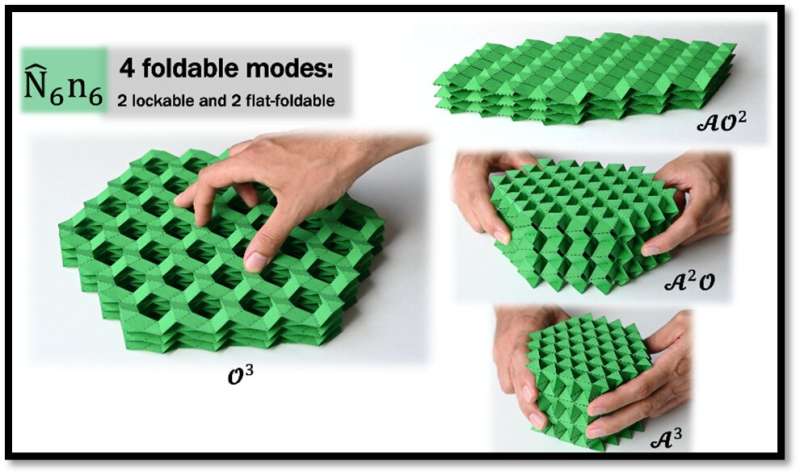Reconfigurable metamaterial that can either fold flat (AO2) in a pattern other than the original (O3), or deploy into two distinct configurations (A2O and A3) that are rigid and load-bearing. Credit: Damiano Pasini et al.
Origami, the Japanese art of folding paper into decorative shapes and figures, has long served as inspiration for industrial design. The concept of folding has been used to build reconfigurable structures, which change their function by changing their shape. These structures are promising for applications such as nanorobots for drug delivery, foldable solar panels for aerospace, and morphable cladding and shading for architecture. However, most of these designs cannot bear heavy loads. Those that can are only able to do so in a certain direction, collapsing along the direction in which they fold. This limits their use as structural materials.
A study by a group of McGill University researchers may provide a solution to this limitation. By merging concepts from origami and kirigami, the practice of folding and cutting paper, researchers developed a class of cellular metamaterials that can flat-fold and lock into several positions that remain stiff across multiple directions.
"Their load-bearing capacity, flat-foldability, and reprogrammability can be harnessed for deployable structures including certain submarines, reconfigurable robots, and low-volume packaging," said Damiano Pasini, Professor in the Department of Mechanical Engineering and lead researcher on the study. "Our metamaterials remain stiff in several directions, yet rigidly flat-foldable metamaterials, attributes unprecedented in the current literature."
The study was published in Nature Communications.
More information: Amin Jamalimehr et al, Rigidly flat-foldable class of lockable origami-inspired metamaterials with topological stiff states, Nature Communications (2022). DOI: 10.1038/s41467-022-29484-1
Journal information: Nature Communications
Provided by McGill University
























